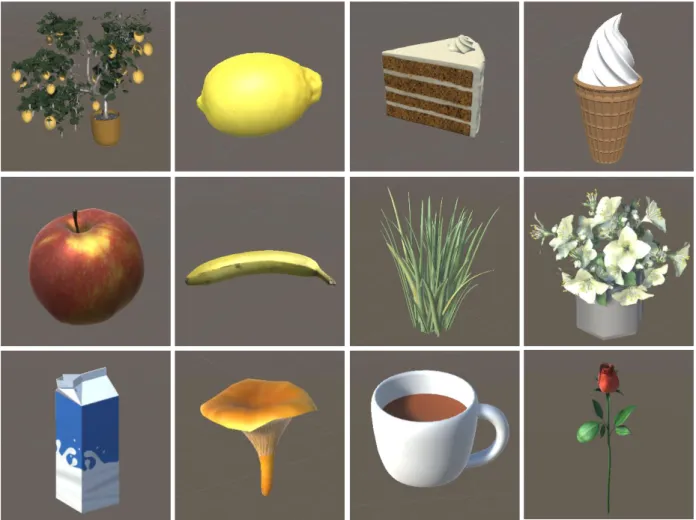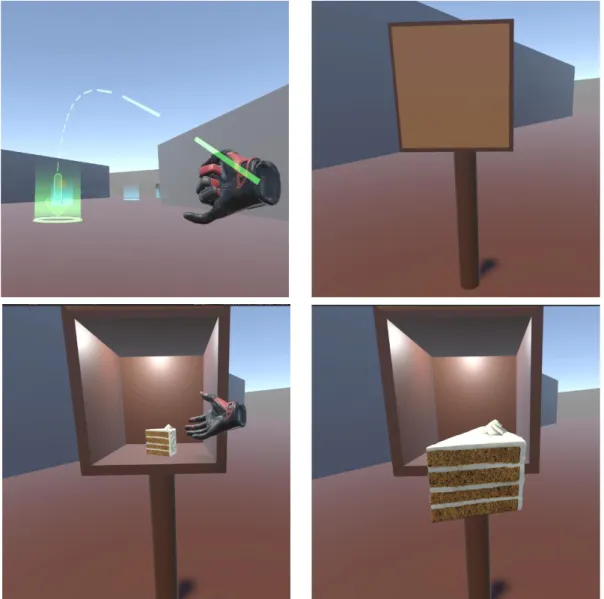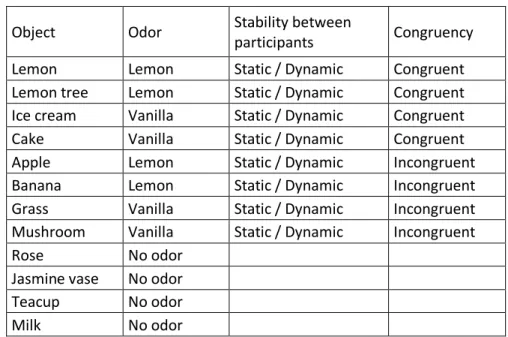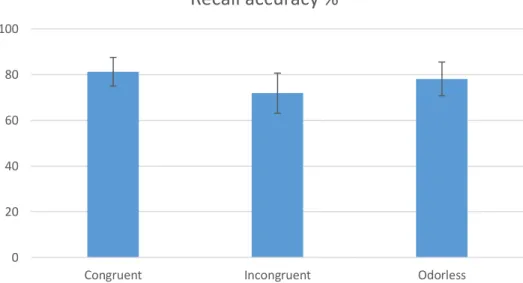The present aim was to investigate the effects of odor congruency and dynamism on the recall of objects encountered in virtual reality (VR). Eight objects had an odor, and half of the participants received objects where the odor was static, half objects where it was dynamic. With dynamically scented objects, the intensity of the scent changed based on the interaction, so that the closer the virtual object was to the user, the stronger its scent.
The congruency of objects and odors was also varied, so that some objects had a semantically congruent odor and some had an incongruent odor. After this, participants again interacted with the same stimuli and rated their experiences in terms of emotion-related valence and arousal. The results showed that odor congruency or dynamism did not have an effect on the amount of objects recalled.
Odor dynamics did not affect valence ratings, but congruent objects were rated as more pleasant than incongruent or odorless.
Introduction
Although making VR a multisensory experience is meeting increasing interest, for a long time the focus of research has mostly been on the dominant senses of sight and hearing, and sometimes touch, both within and outside of virtual reality development. As virtual reality technology has improved, the visuals and accompanying sound have become increasingly high quality and therefore immersive. The main part of this thesis is to study the effects of smells inside a virtual reality environment.
Studying the topic will provide important insights to aid in future research into incorporating odors into multisensory virtual reality experiences. In real life, the smell of an object will intensify when it is brought closer to the nose, but currently the same rule does not apply in virtual environments. The purpose of the experiment is to investigate whether changing the intensity of an odor in virtual reality has any effect on memory and emotions.
A setup that uses digitally controlled clean and scented air circulation and a mask will be used to deliver the scents.
Scents in Virtual Reality
- Multisensory Virtual Reality
- Odors as Part of Multimodal Perception
- Olfactory Displays
- Producing Scents
- Delivering Scents
- Applications of Scented Virtual Reality
We also want to know how scents would work best as part of the experience. Two examples of recent commercial devices intended to be used with existing VR headsets are FeelReal (https://feelreal.com/) and VAQSO (https://vaqso.com/). The fourth method is atomization, where small droplets of the odorant form a mist that can be dispersed in the air.
In the second method, the scented air can be directed directly to a user's direction with airflow. 2004] used head-tracking to detect the position of the user's nose and then fired a scented vortex ring from an air cannon at the nose. The fifth method is an on-body device that can either be worn or attached to the user.
The user experience can be improved when using wearable devices, as the concentration, timing accuracy and disturbances from the natural air movements can be better controlled due to the reduced distance from the device to the nose. If not controlled, they can alter the user's perception of the situation in VR if there is an odor that is completely inappropriate in the situation [Spence et al. Later, they also created a more interactive experience, a cooking game where manipulation of the ingredients, such as meat, onion and curry, in the game resulted in the release of odors from the same ingredients [Nakamoto et al.
![Figure 1. Reality-Virtuality Continuum. Adapted from paper by Milgram and Kishino [1994]](https://thumb-eu.123doks.com/thumbv2/9pdfco/1890302.266468/7.892.134.798.159.332/figure-reality-virtuality-continuum-adapted-paper-milgram-kishino.webp)
The Sense of Smell
- Characteristics of the Sense of Smell
- Perception of Odors
- Odors Influence Behavior
- Olfactory Dysfunction
- Testing of Olfactory Dysfunction
- Odor Memory
- The Neuropsychology Behind Odor Memory
- Odor Memories Can Be Explicit or Implicit
- Odors Evoke Emotional Memories
- Odors Enhance Recall
Inhaled chemicals travel to the nasal cavity where they attach to some of the 6–30 million olfactory sensory neurons in the olfactory epithelium. From neurons in the epithelium, electrical signals about the chemical structures of molecules are directed to the olfactory bulb, which is responsible for sending information forward to the primary (eg, piriform cortex, amygdala) and secondary olfactory cortex. Different areas of the olfactory tract are responsible for perception, discrimination, recognition and.
The way a smell is perceived depends on many factors, not only the chemical composition of the smell or its intensity [Thomas-Danguin et al. Only odorants that were below the detection threshold affected the likability of the displayed faces. Many of the undetected odors are also encoded in the implicit odor memory discussed in Chapter 2.2.
It has also been suggested that adaptation depends on the salience of the odor [Kobayashi et al. Dysfunction can be in any of the subparts of olfaction from detection and intensity discrimination to recognition and identification. Changes in the sense of smell are the result of diseases of the limbic system, which is responsible for the perception and recognition of smells.
The amygdala has been shown to appropriately process the combination of arousal level and valence triggered by a stimulus to form a more complex and comprehensive one. The smell of food may be perceived as more rewarding and pleasant when we are hungry due to learned associations between the smell of food and the rewarding act of eating in the amygdala and hippocampus [Rouby et al. Recognition and identification of odors are part of explicit memory, since explicitly remembered odors are remembered consciously.
The memory of the smell was shown to be implicit because they did not remember smelling it in the rooms, but still associated the smell with the room they had previously visited. Some people say that the most powerful feature of the olfactory memory is the so-called. The effects of double coding have also been suggested as one of the reasons.
In addition, some objects had an odor that matched the visual appearance and others did not.

Methods
- Participants
- Equipment
- Objects
- Virtual Environment
- Odors
- Experimental Procedure
- Measurements and Goals for Data Analysis
Once the box was open, the object inside had to be picked up and moved into the air for closer examination. The placement of the objects was randomized so that the objects were in a different order for each participant to reduce any bias. The participants were asked to do a free recall task of the objects encountered, as well as to evaluate how pleasant and exciting interaction with each object felt.
Next, the participant was instructed to sit on a chair and put on a headset and a VR mask. Within the virtual environment, they were presented with a training area where participants could practice locomotion, opening a box, and picking up an unscented object (gray ball). The participant was instructed to go through the corridor at his own pace, opening all the boxes along the way.
In four of the objects, the intensity of the odor increased in three levels as the participant moved the object closer to themselves, and in four objects the intensity remained the same. After the contestant went through all the boxes, the headset was removed and they were given a free recall task. The participant was given a pen and paper and had to write down as many objects as possible that he could remember from the hallway.
In the third and final phase, the participant was again put on the headphones, mask and controller and presented with the same corridor. The center of both scales represented a neutral point, i.e. neither unpleasant nor pleasant. A free recall task was administered to measure the independent recall of encountered items to determine whether the odors received had any effect on short-term memory.
Because memorization of the items was tested by incidental learning, participants were not told that the experiment would involve a recall task. The effects of odors on valence and arousal due to varying intensity may be stronger than in previous research where emotional ratings were neutral.
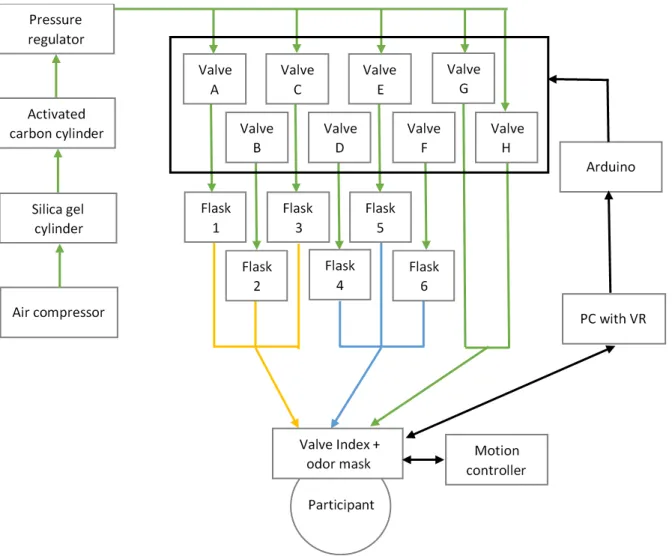
Results
- Recall accuracy
- Valence Ratings
- Arousal Ratings
- Discussion
As shown in Figure 10, objects with congruent odors appear to be rated as more pleasant than incongruent and odorless ones. Post hoc pairwise comparisons indicated that congruent items were rated significantly more pleasant than incongruent items MD = 1.3, p = .03 or odorless, MD = 1.1, p = .03. To determine the effects of odor stability on valence, an independent samples t-test was performed (see Figure 11).
There was no statistically significant difference in the ratings of valence between static and dynamic objects, t p = 0.940. As seen in Figure 12, objects with incongruent odors were rated slightly more arousing than congruent and odorless objects and the odorless slightly more relaxing than congruent and incongruent objects. Dynamically scented objects were rated as slightly more arousing than the other objects (see Figure 13).
Independent samples t-test showed no statistically significant difference in ratings of arousal between static and dynamic objects, t p = 0.277. Odor stability also had nothing but a non-significant trend for better recall of dynamic objects. However, in the current study, incongruent objects tended to elicit the highest arousal ratings, but were not recalled better than congruent or odorless.
On the other hand, dynamic objects tended to elicit higher arousal ratings than static ones and were recalled better. The main result of the experiment was that congruent objects were rated as more pleasant (1.75) than incongruent (0.47) or odorless (0.66). 2021] know that congruent odors increase affective responses in VR experiences more than incongruent or odorless odors.
The object-odor pairs that were congruent may be more pleasant than incongruent pairs because participants smelled what they expected to smell. There were statistically nonsignificant trends for incongruent objects to elicit higher ratings of arousal than congruent or odorless ones.
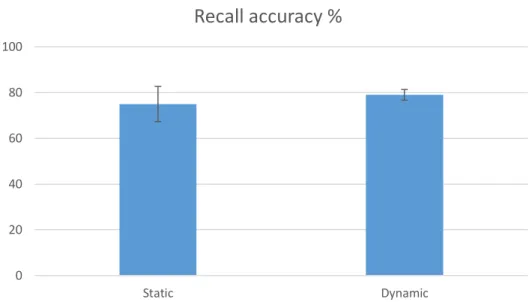
Conclusions
Evaluering af vigtigheden af multi-sensorisk input på hukommelse og følelsen af tilstedeværelse i virtuelle miljøer. Jussi Rantala, Katri Salminen, Poika Isokoski, Ville Nieminen, Markus Karjalainen, Jari Väliaho, Philipp Müller, Anton Kontunen, Joni Leivo, Anca Telembeci, Jukka Lekkala, Pasi Kallio & Veikko Surakka. Katri Salminen, Jussi Rantala, Poika Isokoski, Marko Lehtonen, Philipp Müller, Markus Karjalainen, Jari Väliaho, Anton Kontunen, Ville Nieminen, Joni Leivo, Anca Andreea Telembeci, Jukka Lekkala, Pasi Kallio og Veikko Surakka.
Effects of cognitive factors on perceived odor intensity in adaptation/surprise processes: from 2 different methods of odor presentation. The perception of odor objects in everyday life: a review on the processing of odor mixtures.
![Figure 2. The Sensorama. Reproduced from Heilig [1962].](https://thumb-eu.123doks.com/thumbv2/9pdfco/1890302.266468/8.892.149.763.538.914/figure-sensorama-reproduced-heilig.webp)
![Figure 3. Scent delivery methods illustrated by Yanagida [2012]. © [2012] IEEE](https://thumb-eu.123doks.com/thumbv2/9pdfco/1890302.266468/14.892.229.681.499.1011/figure-scent-delivery-methods-illustrated-yanagida-ieee.webp)
